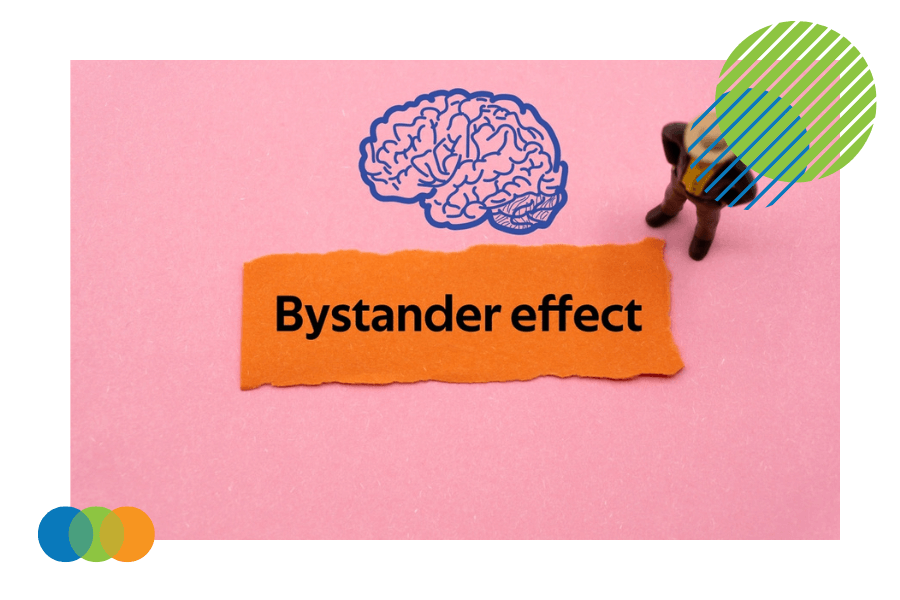 |
Written by Liz McDermott |

Bystander intervention training is important for creating a safer and more inclusive workplace. It teaches employees how to recognize and intervene in situations of harassment or discrimination. Bystander intervention can help organizations prevent and address aggravation, create a culture of open communication, and equip employees to take action when they see inappropriate behavior.
This post overviews bystander intervention methods, explores the benefits, and provides best practices for businesses looking to implement different methods that drive positive impact.

The Bystander Effect and Why It Matters
The bystander effect occurs when individuals fail to intervene when someone needs help simply because other people are present. This phenomenon has recently gained significant attention, especially in light of the rise in incidents of anti-Asian harassment targeting Asian American folks. Understanding this social phenomenon is crucial in addressing and preventing aggravation.
Bystander inaction is often attributed to a diffusion of responsibility among community members. When faced with a situation where someone is targeted or harassed, people may assume that someone else will help, leading to collective inaction. This effect is compounded by the presence of a larger number of people, as each individual feels less personally responsible for taking action. In the context of xenophobic harassment, this can perpetuate a cycle of silence and inaction, allowing the harassment of Asian Americans to continue without consequences.
Recognizing the bystander effect and its impact is crucial for creating a safer and more inclusive society. By understanding the psychological dynamics behind this phenomenon, individuals can actively work towards overcoming their biases and hesitation to intervene.
In the case of anti-Asian harassment, addressing the bystander inaction is particularly important. Asian Americans have been disproportionately targeted and face unique challenges when reporting incidents and seeking help. By encouraging individuals to break the cycle of inaction and stand up against aggravation, we can create a community that actively supports and protects Asian American individuals.
Combating this social phenomenon requires a collective effort from community partners and a commitment to creating a society where everyone feels safe and valued.
What is Bystander Intervention Training?
A form of interactive training that teaches employees how to recognize and interfere effectively in situations of harassment or discrimination. It encourages employees to become active bystanders when they see inappropriate behavior.
The training focuses on empowering individuals to recognize and safely intervene to prevent aggravation and hate incidents while ensuring their own safety.
At its core, bystander intervention training provides the skills and confidence to create a work environment where everyone feels safe and respected. The goal is to create a philosophy of collective responsibility and openness where people from all backgrounds feel confident intervening in situations of harassment or discrimination.

Bystander Intervention Methodology: 5Ds
In light of the increasing incidents of hate crimes motivated by bias, the 5Ds approach has emerged as an effective bystander intervention method:
- Distract
Distraction involves diverting the attention of the harasser or aggressor away from the victim. This can be done by engaging in a conversation or creating a distraction that shifts the focus away from the incident. By intervening in this way, spectators can help diffuse the situation and relieve the victim. - Delegate
Delegation is another important strategy. It entails asking someone else to interfere in the situation on behalf of the victim. This could involve seeking assistance from someone in authority or asking someone nearby to distract the harasser. Delegation is particularly useful when the passerby feels unsure about directly confronting the aggressor. - Document
Documenting the incident is also crucial in bystander intervention. By taking photos or videos or writing down details of what transpired, spectators can provide valuable evidence that can be used to hold the harasser accountable. Documentation can also help victims seek justice and support their claims. - Delay
A strategy that involves waiting for a safe opportunity to interfere. Bystanders can choose to wait for a moment when it is less risky or when there are more people around who can provide support. Delaying intervention allows spectators to assess the situation and plan their actions effectively. - Direct
Encourages bystanders to directly confront the harasser or aggressor. This can involve speaking up and challenging their behavior, expressing support for the victim, or calling out the aggravation in a public setting. Direct intervention sends a clear message that such behavior will not be tolerated.
By utilizing these five strategies, bystanders can actively support victims and confront prejudice within different communities.

Benefits of Bystander Intervention Training
Bystander intervention programs have been developed to empower individuals to take action when witnessing harassment or prejudice. These programs provide strategies and techniques for safely intervening, such as distracting the harasser or supporting the victim.
Education on how to be an active passerby can have a number of benefits for companies, including:
- Creating a culture of open communication and mutual respect.
- Empowering employees to recognize and properly interfere in situations of harassment or discrimination.
- Reducing the prevalence of harassment and discrimination in the workplace.
- Improving employee morale and engagement.
- Building a sense of community in the workplace.
Bystander intervention programs can help businesses create a philosophy of open communication and mutual respect where everyone feels safe, especially young people.
How to Address Sexual Harassment Through Bystander Intervention Training
In response to the growing concern over sexual harassment in the workplace, the city of Chicago has implemented new training requirements for employees and managers. These requirements include one hour of employee Chicago sexual harassment prevention training and two hours for managers and supervisors.
Additionally, all employees must receive one hour of bystander intervention training each year. The goal is to train employees to take action and intervene when they witness sexual misconduct at work.
To ensure compliance with the new training requirements, employers in Chicago had until June 30, 2023, to complete the training for the 2022/2023 year. Failure to comply could result in fines ranging from $500 to $1,000 per offense.
Addressing sexual harassment through bystander intervention training is a proactive approach that recognizes the importance of collective responsibility in creating a safe and respectful work environment. Businesses can foster an environment where everyone feels supported and protected by empowering employees to intervene when they witness inappropriate behavior.
Using Elearning for Bystander Intervention Training
Bystander intervention training explores bystanders' role in addressing and preventing harassment, prejudice, and misconduct. Using elearning for this type of training ensures all workers are trained on the same educational content at their convenience while helping organizations track completion to ensure regulatory compliance. Online training can help cultivate a philosophy of accountability and responsibility within the workplace.
To assist companies in meeting these requirements, Vubiz offers a 60-minute bystander intervention training online course designed to meet the Chicago standards. This course delves into various topics, such as recognizing warning signs, understanding power dynamics, and developing effective intervention methods. The courses can be customized to suit each organization's unique needs, providing a convenient and effective solution for fulfilling the bystander intervention training mandate.

Best Practices for Implementing Bystander Intervention Training
When implementing training, there are a few best practices to keep in mind:
- Assess the organization’s needs and create a plan to address them.
- Identify the educational objectives and audience.
- Determine regulatory requirements.
- Make sure the training is tailored to the organization.
- Make sure the training is engaging and interactive.
- Provide resources for employees to refer to.
- Create a safe and inclusive environment.
- Empower employees to speak up.
- Provide clear expectations for employees.
These best practices can help companies ensure that training is effective and engaging. By creating a safe and inclusive environment, providing clear expectations, and tailoring the training to the organization, businesses can create a culture of open communication and mutual respect where everyone feels safe and respected.
The Importance of Developing a Culture of Open Communication and Mutual Respect
Cultural awareness entails recognizing and appreciating the differences in behaviors and beliefs among various cultures. It enables individuals to interact successfully in diverse environments and promotes empathy and respect while enhancing leadership and communication skills. A culture of open communication and mutual respect ultimately strengthens relationships and creates a harmonious and productive work environment.
Conclusion: Businesses Can Respond to Violence Through Worker Education
Active bystander training teaches employees how to recognize and intervene effectively in situations of harassment or discrimination. Workplace sexual harassment and discrimination prevention training can help businesses prevent and address aggravation, create a culture of open communication, and equip workers to take action when they see inappropriate behavior. Companies can ensure that their training is effective and engaging by understanding the bystander effect, the benefits of training, and the best practices for implementing it.
Education is important for creating safe and inclusive workplaces and communities. It can empower individuals to take action and help prevent violence, harassment, and discrimination in the workplace.
For more information, please contact us to inquire about our Chicago Sexual Harassment Prevention training.

